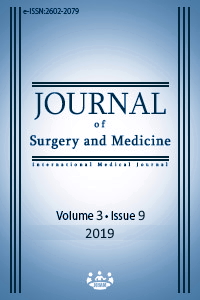Prognostic performance of optic nerve sheath diameters in CT images and serum procalcitonin levels in traumatic brain injury patients in the intensive care unit: A retrospective cohort study
Keywords:
Optic nerve Sheath Diameter, Procalcitonin, Traumatic brain injuryAbstract
Aim: Traumatic brain injury (TBI) is one of the common emergencies with a high mortality rate. It is difficult to determine the mortality and prognosis of TBI in the intensive care unit (ICU). The aim of this study is to assess the prognostic relationship of optic nerve sheath diameters (ONSD) as seen on computerized tomography (CT) images as well as serum procalcitonin (PCT) levels to mortality and Glasgow Outcome Scale (GOS) scores of patients with traumatic brain injury in the ICU.
Methods: Data from 78 traumatic brain injury patients who were admitted to an ICU, underwent brain CT and had serum PCT levels measured, were investigated retrospectively. Patients’ data were gathered from ICU medical records. The ONSD was measured at 3 mm behind the globe.
Results: The mean age of the patients was 57.11 (17.07) years. 57.7% of the patients were males, and 42.3% were females. The cut-off ONSD and serum PCT values were evaluated to determine mortality and prognosis (Cut-off values: right ONSD: 5.44, left ONSD: 5.37, PCT: 3.95 for mortality; right ONSD: 5.26, left ONSD: 5.28, PCT: 2.29 for GOS, respectively).
Conclusion: ONSD measurements and serum PCT levels are associated with mortality and prognosis in traumatic brain injury patients.
Downloads
References
Prabhakaran K, Petrone P, Lombardo G, Stoller C, Policastro A, Marini CP. Mortality rates of severe traumatic brain injury patients: impact of direct versus nondirect transfers. J Surg Res. 2017;219:66–71. doi: 10.1016/j.jss.2017.05.103
Waheed S, Baig MA, Siddiqui E, Jamil D, Bashar M, Feroze A. Prognostic significance of optic nerve sheath diameter on computed tomography scan with severity of blunt traumatic brain injury in the emergency department. J Pak Med Assoc. 2018;68:268–71.
Carney N, Totten AM, OʼReilly C, Ullman JS, Hawryluk GW,Bell MJ ,et al.Guidelines for the management of severe traumatic brain injury, fourth edition. Neurosurgery. 2017;80:6-15. doi: 10.1227/NEU.0000000000001432
Lee SH, Yun SJ. Optic nerve sheath diameter on facial CT: a tool to predict traumatic brain injury. Eur J Trauma Emerg Surg. 2018 Oct 15. doi: 10.1007/s00068-018-1035-310.1007/s00068-018-1035-3
Sauerland S, Hensler T, Bouillon B, Rixen D, Raum MR, Andermahr J et al. Plasma levels of procalcitonin and neopterin in multiple trauma patients with or without brain injury. J Neurotrauma. 2003;20:953–60. doi: 10.1089/089771503770195803
Legrand A, Jeanjean P, Delanghe F, Peltier J, Lecat B, Dupont H. Estimation of optic nerve sheath diameter on an initial brain computed tomography scan can contribute prognostic information in traumatic brain injury patients. Crit Care. 2013;17:R61. 10.1186/cc12589
Ok G, Aydin D, Erbüyün K, Gürsoy C, Taneli F, Bilge S, et al. Neurological outcome after cardiac arrest: a prospective study of the predictive ability of prognostic biomarkers neuron-specific enolase, glial fibrillary acidic protein, S-100B, and procalcitonin. Turkish J Med Sci. 2016; 46:1459–68. doi: 10.3906/sag-1503-64
Downloads
- 1225 1643
Published
Issue
Section
How to Cite
License
Copyright (c) 2019 Canan Gürsoy, Güven Gürsoy, Semra Gümüş Demirbilek
This work is licensed under a Creative Commons Attribution-NonCommercial-NoDerivatives 4.0 International License.
















